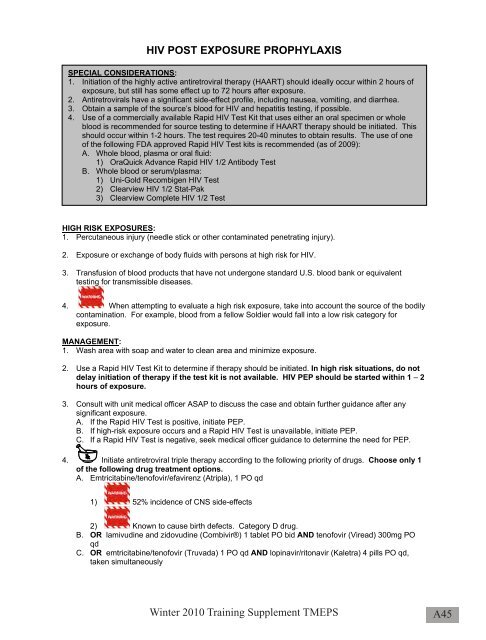201021U. S. Special Operations Command (USSOCOM)
201021U. S. Special Operations Command (USSOCOM)
201021U. S. Special Operations Command (USSOCOM)
You also want an ePaper? Increase the reach of your titles
YUMPU automatically turns print PDFs into web optimized ePapers that Google loves.
HIV POST EXPOSURE PROPHYLAXIS<br />
SPECIAL CONSIDERATIONS:<br />
1. Initiation of the highly active antiretroviral therapy (HAART) should ideally occur within 2 hours of<br />
exposure, but still has some effect up to 72 hours after exposure.<br />
2. Antiretrovirals have a significant side-effect profile, including nausea, vomiting, and diarrhea.<br />
3. Obtain a sample of the source’s blood for HIV and hepatitis testing, if possible.<br />
4. Use of a commercially available Rapid HIV Test Kit that uses either an oral specimen or whole<br />
blood is recommended for source testing to determine if HAART therapy should be initiated. This<br />
should occur within 1-2 hours. The test requires 20-40 minutes to obtain results. The use of one<br />
of the following FDA approved Rapid HIV Test kits is recommended (as of 2009):<br />
A. Whole blood, plasma or oral fluid:<br />
1) OraQuick Advance Rapid HIV 1/2 Antibody Test<br />
B. Whole blood or serum/plasma:<br />
1) Uni-Gold Recombigen HIV Test<br />
2) Clearview HIV 1/2 Stat-Pak<br />
3) Clearview Complete HIV 1/2 Test<br />
HIGH RISK EXPOSURES:<br />
1. Percutaneous injury (needle stick or other contaminated penetrating injury).<br />
2. Exposure or exchange of body fluids with persons at high risk for HIV.<br />
3. Transfusion of blood products that have not undergone standard U.S. blood bank or equivalent<br />
testing for transmissible diseases.<br />
4. When attempting to evaluate a high risk exposure, take into account the source of the bodily<br />
contamination. For example, blood from a fellow Soldier would fall into a low risk category for<br />
exposure.<br />
MANAGEMENT:<br />
1. Wash area with soap and water to clean area and minimize exposure.<br />
2. Use a Rapid HIV Test Kit to determine if therapy should be initiated. In high risk situations, do not<br />
delay initiation of therapy if the test kit is not available. HIV PEP should be started within 1 – 2<br />
hours of exposure.<br />
3. Consult with unit medical officer ASAP to discuss the case and obtain further guidance after any<br />
significant exposure.<br />
A. If the Rapid HIV Test is positive, initiate PEP.<br />
B. If high-risk exposure occurs and a Rapid HIV Test is unavailable, initiate PEP.<br />
C. If a Rapid HIV Test is negative, seek medical officer guidance to determine the need for PEP.<br />
4. Initiate antiretroviral triple therapy according to the following priority of drugs. Choose only 1<br />
of the following drug treatment options.<br />
A. Emtricitabine/tenofovir/efavirenz (Atripla), 1 PO qd<br />
1) 52% incidence of CNS side-effects<br />
2) Known to cause birth defects. Category D drug.<br />
B. OR lamivudine and zidovudine (Combivir®) 1 tablet PO bid AND tenofovir (Viread) 300mg PO<br />
qd<br />
C. OR emtricitabine/tenofovir (Truvada) 1 PO qd AND lopinavir/ritonavir (Kaletra) 4 pills PO qd,<br />
taken simultaneously<br />
Winter 2010 Training Supplement TMEPS<br />
A45
















